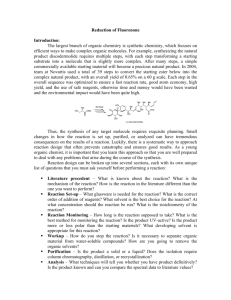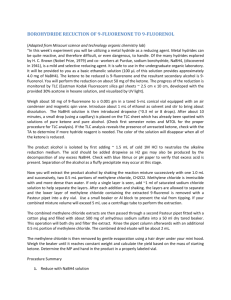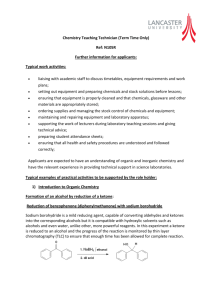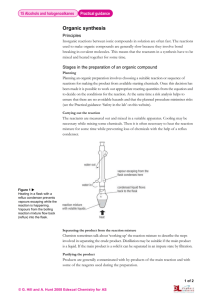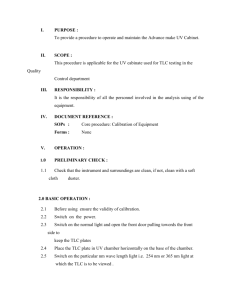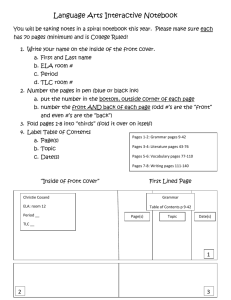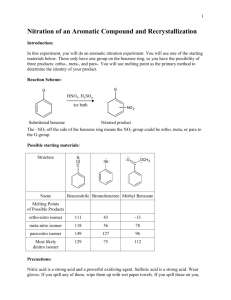View/Download
advertisement
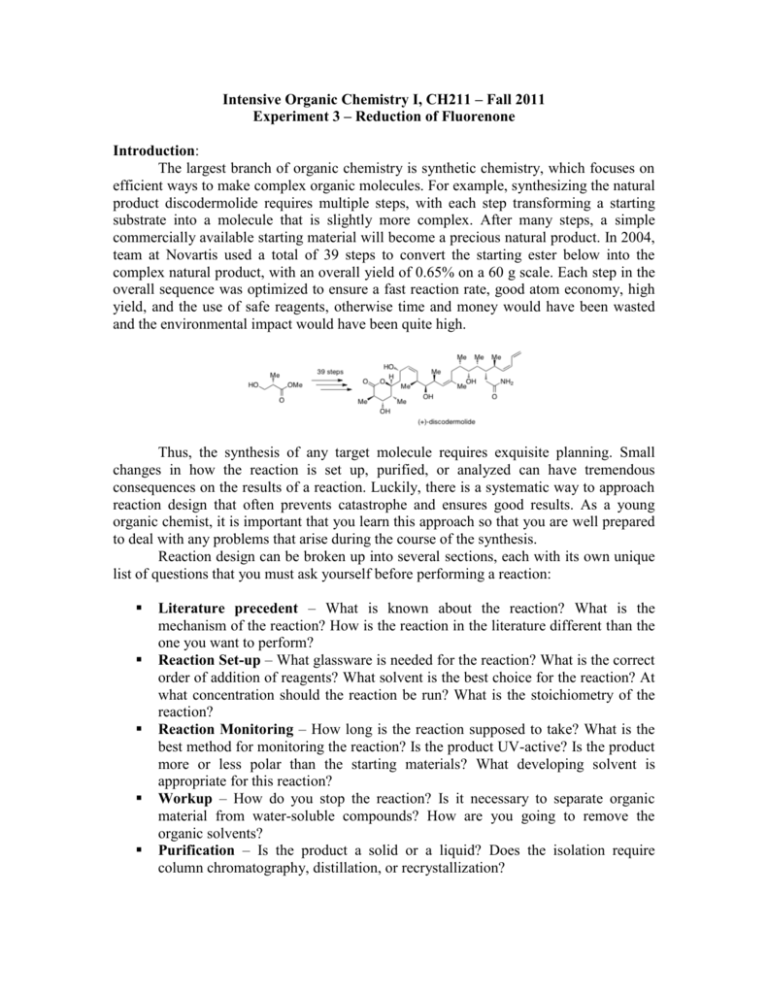
Intensive Organic Chemistry I, CH211 – Fall 2011 Experiment 3 – Reduction of Fluorenone Introduction: The largest branch of organic chemistry is synthetic chemistry, which focuses on efficient ways to make complex organic molecules. For example, synthesizing the natural product discodermolide requires multiple steps, with each step transforming a starting substrate into a molecule that is slightly more complex. After many steps, a simple commercially available starting material will become a precious natural product. In 2004, team at Novartis used a total of 39 steps to convert the starting ester below into the complex natural product, with an overall yield of 0.65% on a 60 g scale. Each step in the overall sequence was optimized to ensure a fast reaction rate, good atom economy, high yield, and the use of safe reagents, otherwise time and money would have been wasted and the environmental impact would have been quite high. Thus, the synthesis of any target molecule requires exquisite planning. Small changes in how the reaction is set up, purified, or analyzed can have tremendous consequences on the results of a reaction. Luckily, there is a systematic way to approach reaction design that often prevents catastrophe and ensures good results. As a young organic chemist, it is important that you learn this approach so that you are well prepared to deal with any problems that arise during the course of the synthesis. Reaction design can be broken up into several sections, each with its own unique list of questions that you must ask yourself before performing a reaction: Literature precedent – What is known about the reaction? What is the mechanism of the reaction? How is the reaction in the literature different than the one you want to perform? Reaction Set-up – What glassware is needed for the reaction? What is the correct order of addition of reagents? What solvent is the best choice for the reaction? At what concentration should the reaction be run? What is the stoichiometry of the reaction? Reaction Monitoring – How long is the reaction supposed to take? What is the best method for monitoring the reaction? Is the product UV-active? Is the product more or less polar than the starting materials? What developing solvent is appropriate for this reaction? Workup – How do you stop the reaction? Is it necessary to separate organic material from water-soluble compounds? How are you going to remove the organic solvents? Purification – Is the product a solid or a liquid? Does the isolation require column chromatography, distillation, or recrystallization? Analysis – What techniques will tell you whether you have product definitively? Is the product known and can you compare the spectral data to literature values? As you go through each experiment this semester, be mindful of these factors. They will help you be prepared for laboratory each week and will help you solve problem you might encounter. Reduction of Fluorenone In this week’s experiment, you will be performing your first organic transformation – reduction of a ketone. The reaction results in formation of an alcohol, which is one step lower in oxidation state than a ketone. During the course of the reaction, “H2” is ostensibly added across the carbonyl double bond (hence, a reduction). We will be using the substrate fluorenone and converting it to fluorenol using the reagent sodium borohydride, as shown below. Why is the reduction of a ketone an important reaction to learn? In any synthesis, we often want to control when and where a reaction occurs in a given molecule. To do this, we will often modify the arrangement of functional groups in a molecule so that only one particular functional group will react with a given set of reagents. For oxygencontaining substrates, this often requires changing the oxidation state from alcohol to ketone/aldehyde to carboxylic acid/ester, and vice versa, because those functional groups have different reactivities and will react with a unique set of reagents. In fluorenone, the only functional group that will react with NaBH4 is the ketone, so the reaction should proceed rather smoothly. You will perform the reaction, monitor it by TLC, purify it by column chromatography, and analyze the reaction by 1H NMR and IR spectroscopy. Consider the following scenario for this experiment: You are working at Novartis and have been given the task of optimizing a step in the overall synthetic sequence towards a bioactive natural product. This step requires the simple reduction of a ketone to an alcohol. You want to first run the reaction on a smaller scale to optimize the reaction conditions. Eventually, you want to provide your supervisors with a reaction procedure from which they can use to scale up the reduction. So, you need to decide how you are going to set up the experiment, monitor the reaction, workup the reaction, purify the reaction, and analyze the product. References: 1. Pavia, D. L.; Lampman, G. M.; Kritz, G. S.; Engel, R. G. Introduction to Laboratory Techniques, 4th Ed. Thomson Brooks/Cole: Mason, OH, 2006; pp 4650. Reduction of Fluorenone Equipment: Microscale glassware kit Vacuum tube 25 and 50 mL beakers 10 mL graduated cylinder Pasteur pipets Capillary tubes TLC plates Cotton NMR tubes Chemicals: Fluorenone Sodium borohydride Methanol (2 x 200 mL) Deionized water Hexanes (2 x 200 mL) Acetone (2 x 200 mL) Alumina Dichloromethane CDCl3 Procedure: adapted from Pavia, D. L.; Lampman, G. M.; Kritz, G. S.; Engel, R. G. Introduction to Laboratory Techniques, 4th Ed. Thomson Brooks/Cole: Mason, OH, 2006; pp 46-50. Running the Reaction: Before you set up your reaction, obtain a large TLC plate and 4-5 capillary tubes which you will use to monitor your reaction for a total of 2 minutes (0 s, 15 s, 30 s, 60 s, 90 s, 120 s). Be sure to leave enough room for a reference spot for fluorenone (you need to make this sample yourself in CH2Cl2 – it may be wise to test the concentration of your solution by TLC before running the reaction). You do not need a cospot for monitoring the reaction in this manner and the developing solvent is 100% dichloromethane. Make sure this TLC plate is prepared prior to setting up the reaction. Once you have the plate set up, you will be ready to perform the reaction. In a 10 mL round bottomed flask, add 0.4 g fluorenone and dissolve it in 8 mL methanol. Add a stir bar and stir the mixture at room temperature (do not cap the flask – H2 will evolve during the reaction). On your TLC plate, spot your sample of fluorenone (this is the reference), then spot your reaction mixture with a different capillary tube (this is t = 0 s). Obtain 100 mg (0.1 g) of sodium borohydride (NaBH4) – work quickly as NaBH4 absorbs water from the atmosphere. Add the NaBH4 to the reaction mixture in approximately 5 equal portions at the times indicated (begin recording the time after the first portion has been added). At the sam time, take an aliquot of your reaction mixture with a capillary tube and make a spot on your TLC plate in the appropriate position. Monitor the reaction for a total of 2 minutes, at which point you can develop your TLC plate. Is your reaction complete? Workup and Purification: To the 8 mL of reaction mixture in the round bottomed flask, add 2 mL of water and heat the mixture to a boil or until all of the solid has gone into solution and then remove the flask from the heat and let it slowly cool to room temperature. Collect your product crystals by vacuum filtration on a Hirsch funnel with a filter disc. Wash the crystals with 4:1 MeOH:H2O (3 x 1 mL) and then transfer to a tared beaker. Air or oven dry for a few minutes to remove excess water. Analysis: Obtain a yield of your fluorenol product. Measure the IR spectrum of both fluorenone and fluorenol. Submit a 1H NMR (in ~0.7 mL CDCl3) and an LC/MS (<1 mg in 1.5 mL MeOH) for your fluorenol sample only. Prelab Exercise: These questions do not need to be explicitly answered in writing, but you should be able to answer them prior to your arrival in lab. Some of these questions will form the basis for the discussion section of the Org. Syn. Prep. You should also have some information already uploaded into Ensemble (reaction scheme, reagent table, etc.). 1. Fluorene is part of a class of compounds called polycyclic aromatic hydrocarbons (PAHs). Why might exposure to this group of compounds be of concern to your health? (Note: the First Responders’ healthcare bill that passed Congress last December provided funding to cope with the health effects of these chemicals at Ground Zero after the collapse of the Twin Towers). 2. Besides TLC, how else can you tell that your reaction is complete? 3. What do your TLCs tell you about the rate of the reduction? 4. Which method of purification is preferred in organic chemistry – recrystallization or column chromatography? By what parameter did you make your assessment? Post-Lab Assignment: Organic Syntheses Preparation, due in Lab one week after you complete the experiment.
